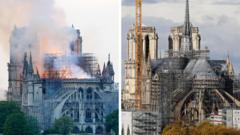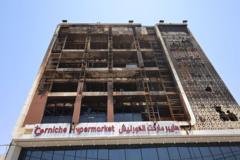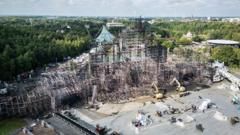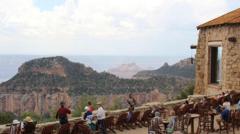**Following a devastating fire in 2019, Notre-Dame Cathedral has undergone a monumental restoration, merging ancient craftsmanship with modern technology to reclaim its splendor.**
**Restoration of Notre-Dame: A Journey from Ashes to Brilliance**

**Restoration of Notre-Dame: A Journey from Ashes to Brilliance**
**French President Macron Reveals the Transformed Heart of Paris’ Historic Cathedral**
In a highly anticipated live broadcast, French President Emmanuel Macron unveiled the stunning renovations of Notre-Dame Cathedral, a building substantially affected by the catastrophic fire of 2019. The historic structure, awakened after years of laborious restoration, showcases both its age-old charm and modern enhancements.
At the heart of the renovations lies the iconic spire—a symbol of the cathedral’s defiance. Contrary to popular belief, the spire that collapsed in 2019 was not an original medieval structure but a neo-Gothic creation by architect Eugène Viollet-Le-Duc from the 19th century. The replacement spire is now crafted with a blend of traditional methods and cutting-edge technology, featuring a wooden base assembled using precise computer-aided design and perched atop it is a gilded cock, now encasing relics and a parchment honoring the 2,000 artisans who contributed to the restoration.
The cleanliness of the limestone stonework has astounded visitors; all 40,000 square meters have been carefully cleaned, with some blocks replaced, sourced from northern France. The restoration experts meticulously analyzed the original limestone, ensuring any replacements reflected its natural features.
The roof, destroyed by flames, has been rebuilt using 1,200 oak trees, hand-selected for their structural integrity—restoring the wood frame with techniques from the 13th century. Accurate measurements from extensive research conducted by architect Remi Fromont guided this labor-intensive endeavor.
Moreover, the gargoyles and exterior sculptures, once covered in soot, have been revitalized following a revised cleaning process tailored to preserve their intricate details. Inside, prominent sculptures and the glimmering stained-glass windows underwent extensive rejuvenation. The cleaning revealed long-hidden vibrancy, infusing the interior with light—a testament to the original artistry.
Other integral elements, such as the renowned 18th-century great organ—the pride of the cathedral—were painstakingly restored after an accumulation of lead dust threatened its functionality. Following meticulous repairs and retuning, it is now poised to resonate with its historic voice.
In addition to structural renovations, the internal layout has evolved. New bronze altars, chalices, and seating have been introduced, making way for a streamlined, modern worship experience. Archaeological excavations beneath the cathedral unearthed treasures like the remains of the 13th-century rood-screen, promising not only historical significance but also visually dynamic displays of art from long ago.
While the restoration has made significant strides, future work remains; extensive treatments for the exterior walls will commence, alongside the conversion of the Hôtel-Dieu hospital into a museum, offering an even deeper connection to the cathedral's storied past.
With each stone laid and every wood beam restored, Notre-Dame stands poised to welcome visitors once more, a monument rebuilt from adversity, now radiant in its rich history and cultural significance.
At the heart of the renovations lies the iconic spire—a symbol of the cathedral’s defiance. Contrary to popular belief, the spire that collapsed in 2019 was not an original medieval structure but a neo-Gothic creation by architect Eugène Viollet-Le-Duc from the 19th century. The replacement spire is now crafted with a blend of traditional methods and cutting-edge technology, featuring a wooden base assembled using precise computer-aided design and perched atop it is a gilded cock, now encasing relics and a parchment honoring the 2,000 artisans who contributed to the restoration.
The cleanliness of the limestone stonework has astounded visitors; all 40,000 square meters have been carefully cleaned, with some blocks replaced, sourced from northern France. The restoration experts meticulously analyzed the original limestone, ensuring any replacements reflected its natural features.
The roof, destroyed by flames, has been rebuilt using 1,200 oak trees, hand-selected for their structural integrity—restoring the wood frame with techniques from the 13th century. Accurate measurements from extensive research conducted by architect Remi Fromont guided this labor-intensive endeavor.
Moreover, the gargoyles and exterior sculptures, once covered in soot, have been revitalized following a revised cleaning process tailored to preserve their intricate details. Inside, prominent sculptures and the glimmering stained-glass windows underwent extensive rejuvenation. The cleaning revealed long-hidden vibrancy, infusing the interior with light—a testament to the original artistry.
Other integral elements, such as the renowned 18th-century great organ—the pride of the cathedral—were painstakingly restored after an accumulation of lead dust threatened its functionality. Following meticulous repairs and retuning, it is now poised to resonate with its historic voice.
In addition to structural renovations, the internal layout has evolved. New bronze altars, chalices, and seating have been introduced, making way for a streamlined, modern worship experience. Archaeological excavations beneath the cathedral unearthed treasures like the remains of the 13th-century rood-screen, promising not only historical significance but also visually dynamic displays of art from long ago.
While the restoration has made significant strides, future work remains; extensive treatments for the exterior walls will commence, alongside the conversion of the Hôtel-Dieu hospital into a museum, offering an even deeper connection to the cathedral's storied past.
With each stone laid and every wood beam restored, Notre-Dame stands poised to welcome visitors once more, a monument rebuilt from adversity, now radiant in its rich history and cultural significance.























